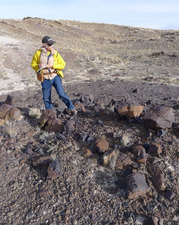 WSGS Mineral Investigations
WSGS geologists this summer spent a total of 970 hours in the field and walked 375 miles to gather data and samples for their mineral investigations. Photo: Wayne Sutherland, WSGS geologist, conducting research for the iron study.
The Wyoming Legislature has
requested and funded several WSGS mineral investigations for resources that
could prove economic for the state. These include iron, rare earth elements
(REEs), zeolites, and lithium. All studies will result in published reports,
which will be available on the agency’s website in July 2016.
Iron
The WSGS recently completed
its iron investigation. The
91-page report “Iron Resources in Wyoming, Report of Investigations No. 67” is
available for $18 via the WSGS website
or as a free download.
The results of this study show iron-rich rocks occur across Wyoming and recent exploration indicates at least one
potentially large and previously unknown deposit in the Rattlesnake
Hills-Granite Mountain area. Iron ore also remains in the Sunrise and South
Pass areas, where historic mining has occurred.
Rare Earth Elements
The current rare earths study is in follow-up to research completed by
the agency in 2013. Wyoming will soon have an active REE
industry, with mining operations planned for the Bear Lodge Mountains in Crook
County and the potential for additional deposits in the state. REEs are
used in numerous high-tech devices. China currently dominates the supply and export of REEs
worldwide.
Although REEs are
relatively abundant in the Earth’s crust, they are rarely concentrated into
mineable ore deposits. For this study, WSGS geologists are collecting additional samples from known, potential,
and suspected REE host rocks not previously investigated. These samples will be
analyzed for REE and other potential economic metals and associated elements.
All potential REE locations identified in early WSGS reports, but not
investigated in 2012-2013 will be addressed. Further, sites exhibiting higher
concentrations of REE will be characterized in their mineralogy, rock types,
and geological environments.
Zeolites
WSGS geologists are collecting
samples from known, potential, and suspected zeolite host rocks with the goal
to analyze those samples for a published report. The published results from this
study will also include related maps, and data.
There are more than 50
naturally-occurring zeolite minerals on Earth. Although synthetic zeolites have
been successfully made for specific uses, naturally occurring zeolites have the
advantage of being far less expensive to produce. Unfortunately, these are
limited to specific uses based on each given zeolite mineral’s chemical
composition and crystalline properties. Zeolites have a wide variety of uses,
including agriculture, water and air purification, cat litter, heavy metal
waste control and clean-up, desiccation, catalysis, etc.
Historically, Wyoming had one
commercial zeolite quarry in southern Sweetwater County, which is now closed.
Mining occurred from the Fort LaClede deposit, which produced small amounts of
zeolite.
Lithium
The
WSGS is in the process of reviewing scientific literature as well as acquiring
data from a variety of sources on lithium concentrations in Wyoming. The
results will be published in a WSGS report.
World
demand for lithium is expected to continue to rise in the coming decades.
Lithium is used extensively in batteries for cell phones and electric vehicles,
ceramics and glass making and high strength to weight metal alloys. Currently,
Chile, Australia, China, and Argentina produce most of the world’s lithium from
hard rock mines or groundwater brines. WSGS is conducted this initial
evaluation of the state’s lithium deposits by analyzing lithium concentrations
in selected rock formations, groundwater brines associated with existing oil
and gas wells, and groundwater associated with geothermal and playa deposits.
|